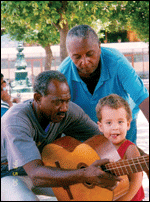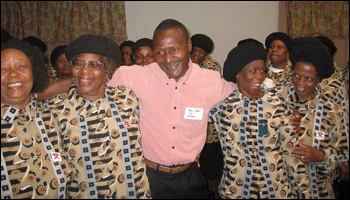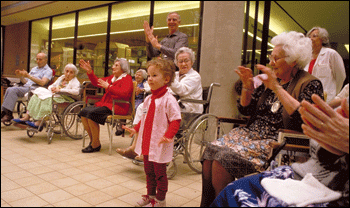 
|
|

Global Age-Friendly Cities Project
Download this brochure in PDF format
(1 page, 194 KB) 
According to United Nations estimates, the number of older persons (60+) will double from the current 600 million to 1.2 billion by 2025, and again, to 2 billion by 2050. The vast majority of older people live in their homes and communities, but in environments that have not been designed with their needs and capacities in mind.
| |
 |
|
Photo: International Federation
on Ageing |
To support Governments in developing and strengthening health and social policies in an ageing world, the World Health Organization (WHO) released a Policy Framework on Active Ageing in 2002. Active ageing policy is defined as "optimizing opportunities for health, participation and security in order to enhance quality of life as people age." The active ageing approach is grounded in the UN-recognized principles of independence, participation, dignity, care and self-fulfilment. It acknowledges the importance of gender, earlier life experiences, and culture on how individuals age. It takes into account the biological, psychological, behavioural, economic, social and environmental factors that operate over the course of a person's life to determine health and well-being in later years.
Since the release of the Active Ageing Framework, it has been used by WHO as a basis for developing guidelines to make front-line primary health care services more "age-friendly" -- that is, more accessible and responsive to the specific needs of older persons. WHO is now turning its attention to the environmental and social factors that contribute to active ageing in urban settings. The aim of the WHO Global Age-Friendly Cities project is to engage cities in several countries to make their communities more age-friendly.
Making cities age-friendly is one of the most effective policy approaches for responding to demographic ageing. One of the reasons for focusing on cities is that major urban centres have the economic and social resources to make changes to become more age-friendly and can thus lead the way for other communities within their countries. In the developed world, three-quarters of older persons live in cities. Although proportionately more older persons live in rural areas in the developing world, rapid urbanization is gradually reversing the picture: large cities already count substantial numbers of older adult residents.
One million people worldwide turn 60 every month; 80% of these live in developing countries. |
|
|
What is an Age-Friendly City?
Older people face increasing challenges due to the sensory and other changes that age brings. In an age-friendly community, policies, services and structures related to the physical and social environment are designed to support and enable older people to "age actively" -- that is, to live in security, enjoy good health and continue to participate fully in society. Public and commercial settings and services are made accessible to accommodate varying levels of ability. Age-friendly service providers, public officials, community leaders, faith leaders and business people:
- recognize the great diversity among older persons,
- promote their inclusion and contribution in all areas of community life,
- respect their decisions and lifestyle choices, and
- anticipate and respond flexibly to aging-related needs and preferences.
 |
Photo: International Federation on Ageing |
Many aspects of urban settings and services can contribute to the participation, health, independence and security of older persons in an age-friendly city. A list of these features is shown in the following table.
AGE-FRIENDLY COMMUNITY |
Participation |
• |
Positive images of older persons |
• |
Accessible and useful information |
• |
Accessible public and private transportation |
• |
Inclusive opportunities for civic, cultural, educational and voluntary engagement |
• |
Barrier-free and enabling interior and exterior spaces |
|
Health |
• |
Places and programs for active leisure and socialization |
• |
Activities, programs and information to promote health, social and spiritual well-being |
• |
Social support and outreach |
• |
Accessible and appropriate health services |
• |
Good air/water quality |
|
Security and Independence |
• |
Appropriate, accessible, affordable housing |
• |
Accessible home-safety designs and products |
• |
Hazard-free streets and buildings |
• |
Safe roadways and signage for drivers and pedestrians |
• |
Safe, accessible and affordable public transportation |
• |
Services to assist with household chores and home maintenance |
• |
Supports for caregivers |
• |
Accessible stores, banks and professional services |
• |
Supportive neighbourhoods |
• |
Safety from abuse and criminal victimization |
• |
Public information and appropriate training |
• |
Emergency plans and disaster recovery |
• |
Appropriate and accessible employment opportunities |
• |
Flexible work practices |
|
|
 |
Photo: Health Canada |
Why Develop an Age-Friendly City?
An age-friendly community benefits people of all ages. Improving air and water quality protects growing children and older persons with environmental sensitivities. Secure neighbourhoods are safe for children, youth, women and older adults. Families experience less worry and stress when their older relations have the services and supports they need. Barrier-free buildings and streets enhance the mobility and independence of both younger and older persons with disabilities. The whole community benefits from the participation of older persons in volunteer or paid work and civic activities. Finally, the local economy benefits from the patronage of older adult consumers.
How will the WHO Conduct the Age-Friendly City Project?
The project focuses on the "lived" experience of older people -- that is, what seniors experience as age-friendly in their daily lives in the community -- and involves them as full partners from start to finish.
| |
 |
|
Photo: Public Health Agency
of Canada |
The WHO and partners from many countries will first consult with older persons, and then with community leaders and experts, to identify the major physical and social barriers to active ageing. Each partner will use this knowledge to develop, implement and evaluate local action plans to make the environment more age-friendly. To share the learnings, the WHO will compile the results into practical "Age-Friendly City" guidelines that could be used by cities around the world.
Acknowledgements
This brochure was produced by the World Health Organization in collaboration with the Public Health Agency of Canada, the Ministry of Health of British Columbia and 2010 Legacies Now. Many other governments and civil society organizations are partners in the Global Age-Friendly Cities project.
|



